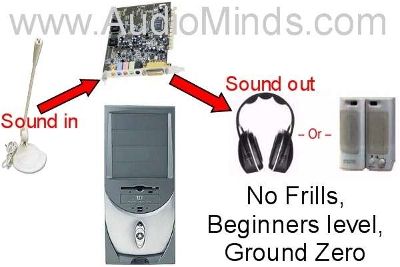


Basic Equipment You'll Need To Get Started
How much equipment do you need to get started? Suprisingly little, actually. With nothing more than a standard PC, you can record, edit, and playback audio tracks. Obviously, the quality of each component will affect the quality of the final product. But many of us got our start in digital recording using entry-level gear. It's OK to start small and work up to better gear as your abilities increase. So, let's start with a basic setup. Basic hardware components:
Basic software components:
That's it. If you've got the above items and want to give digital recording a shot, read on... Connections:Look at the diagram below. The signal starts at the microphone, travels into the Mic Input on the sound card (where it's converted to digital), and moves on to your recording software where it's stored as a WAV file. When you're done recording and you start Playback, the recording software reads the WAV file, and passes it on to your sound card (where it's converted back to analog). The signal then travels out the Line Out jack to your headphones or speakers.
Cables:In this very simplified setup, cabling needs are minimal. Standard, desktop microphones are outfitted with a 1/8", mono plug which fits nicely in the Mic In jack of a standard sound card. Also, most headphones and desktop speakers (note: must be self-powered) come equipped with a 1/8", stereo plug which fits nicely in the Line Out jack of a standard sound card. If your setup is a bit different and you need special cables or adapters, a visit to Radio Shack might be in order.Final Thoughts:Many desktop PCs (and almost all laptops) come equipped with very inexpensive on-board sound. The quality you can expect is, quite frankly, poor. Also, standard sound cards are generally 2-channel. This means you are limited to recording 2 distinct channels at a time. Better quality (and more expensive) sound cards offer quieter performance and better analog-to-digital and digital-to-analog conversions. Many of them also offer more than 2 distinct channels.For these reasons, you may find that you quickly outgrow the equipment we've discussed here. That's why we've addressed more expensive and better quality gear elsewhere on the AudioMinds site. Upgrading from entry-level gear usually involves more complex cabling and software configurations. But the concepts are the same. We hope you find this info helpful. As always, there is help available on the forum. Home ~ Getting Started ~ Recording ~ Mixing ~ Mastering ~ Promotion ~ Troubleshooting ~ Contact Us  If you have a question about Audio, please Visit Our Forum: Audiominds.com Forum. Copyright © 2003 www.AudioMinds.com All Rights Reserved. |